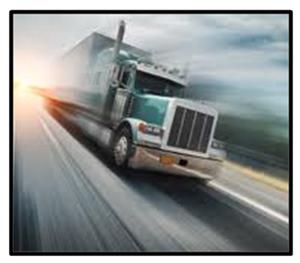Slowing “Big Rigs” with Driver Feedback Signs
TRAFFIC-CALMING TRENDS: How Driver Feedback Signs Help Ensure Speed Compliance in Multi-Modal Terminals and Distribution Centers
Every week, 2 million tractor trailers transport $671 billion worth of goods—some 70 percent of all freight moved—in the U.S. Profit in this billion-dollar industry, is achieved through a delicate balance of speed and safety.
 While the trucking industry is vital in supporting the U.S. economy—estimated at more than $255 billion annually—The United States Department of Transportation estimates that there are more than 500,000 truck accidents each year, and according to TruckInfo.net, one person is injured or killed in a trucking accident every 16 minutes. Contributing to these accidents: speeding drivers and the time it takes to slow a tractor trailer.
While the trucking industry is vital in supporting the U.S. economy—estimated at more than $255 billion annually—The United States Department of Transportation estimates that there are more than 500,000 truck accidents each year, and according to TruckInfo.net, one person is injured or killed in a trucking accident every 16 minutes. Contributing to these accidents: speeding drivers and the time it takes to slow a tractor trailer.
Balancing the need for efficiency and safety in cargo handling locations requires a unique approach to traffic management that considers the needs of foot traffic, personal vehicles, trucks and other heavy machinery. Driver radar feedback signs are becoming the “go-to” tactical solution for traffic calming in today’s busy multi-modal terminals and distribution centers. From SSA Marine—the largest U.S. owned and the largest privately held container terminal operator and cargo handling company—to URS Corporation (now AECOM) and Falkirk Mining Company—some of the world’s busiest heavy construction and commercial grade traffic environments—to Michelin North America and JBS, driver feedback signs are helping slow thousands of tractor trailers a day.
Case Study 1: Michelin North America
Every day more than 450 tractor trailers come and go at the Michelin North America plant in Anderson, S.C.; that’s one every 90 seconds. In 2005, Michelin sought a solution to slow speeding drivers at their plant. They chose to install two Radarsign TC-500S driver feedback signs along the main entry. For two weeks the signs operated in “off” mode; capturing vital data about driver speeds without the drivers’ knowledge. The data revealed:
- 74 percent of drivers were speeding
- 80 percent of speeding drivers were traveling at more than double the posted 20 mph speed limit
“Once the sign was turned ‘on’ we saw an immediate difference,” said Will Irby, Traffic Safety Coordinator at Michelin North America. “We knew drivers were slowing down but Radarsign’s StreetSmarttm data collection software confirmed what we were seeing: 99 percent of drivers began following the speed limit. We reduced 333 speeding big rigs a day to less than 5, just by turning on the driver feedback sign.”
Now, almost six years later, Michelin still boasts a 96 percent speed adherence rate.
Case Study 2: JBS Tolleson, Inc.
At the JBS cattle processing plant in Tolleson, Arizona, some 70 – 80 cattle trucks come through daily. Operating 24 hours a day, with a single entrance/exit, the traffic was highly congested and even dangerous due to speeding drivers. Having observed a Radarsign driver feedback sign in action—effectively slowing speeding truck drivers—JBS Operational Safety and Health Manager Bert Hood purchased a Radarsign TC-500 with a portable base so that it could be moved to slow drivers at multiple points on the JBS campus.
“The biggest single piece of proof that the sign works is when we move it to a different location at the plant: Drivers still slow down at the old location…as if they have been trained,” said Hood. “Now truck drivers brag about how slow they can drive their big rig on the plant…even under the speed limit!”
Because less than 25 percent of the daily plant traffic is truck drivers, JBS wanted a traffic calming solution that would be effective for all vehicles, from sedans to big rigs.
“The viewability of the sign is perfect for our semi-truck drivers since it takes longer for them to slow down,” said Hood. “We see them braking as soon as the sign is in sight—2,000 feet away from the entrance to the plant.”
JBS Tolleson has taken its plant safety to a new level by combining the Radarsign driver feedback sign with a disciplinary system. If drivers are caught speeding, security guards report their license plate information and issue a warning: if they speed again they are not allowed back on plant property. Only a handful of warnings have been issued and no one has been banned from the plant.
“The signs just work. Before, drivers were going about 35 mph but now I’d say everyone has slowed down…at least 99% of drivers now adhere to the 10 mph speed limit,” said Hood.
About Radarsign® Brand Radar Speed Signs:
In 2004, Atlanta-based Radarsign® established new industry standards for traffic calming solutions with the debut of the world’s first armored driver feedback signs. Radarsign radar speed signs are vandal-, weather- and bullet-resistant. They are also the traffic calming industry’s most durable, most ecological and most energy efficient radar speed signs. Engineered and manufactured in the USA, all Radarsign models are MUTCD-compliant and utilize recycled aluminum, innovative LED reflector technology, minimal battery power and solar panels to deliver bright, easy-to-read feedback to drivers. Radarsign products are scientifically proven to reduce drivers’ speeds and have been entrusted to provide safe and effective traffic calming solutions for: municipalities, treasured national parks, schools, neighborhoods, military bases, and private and public development projects across the U.S., Canada and overseas. www.radarsign.com.
©2019 Radarsign. Any use of “Traffic Calming Trends” or portions thereof, including reproduction, modification, distribution or republication, without the prior written consent of Radarsign, is strictly prohibited.
